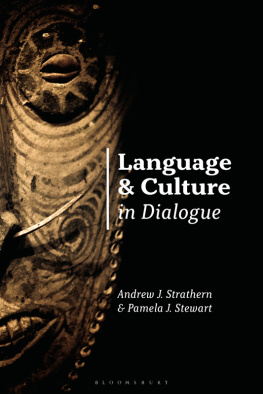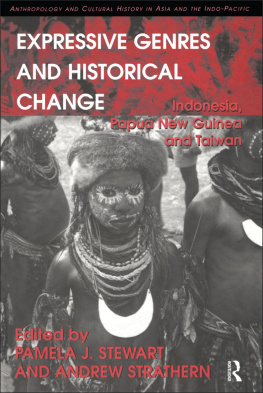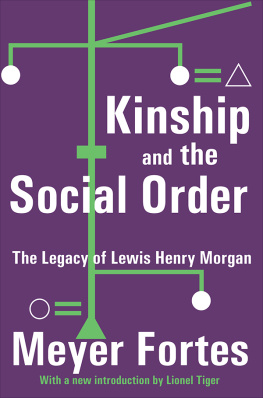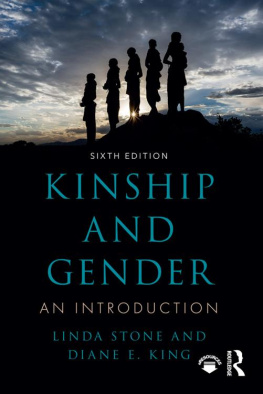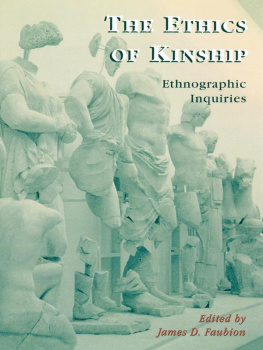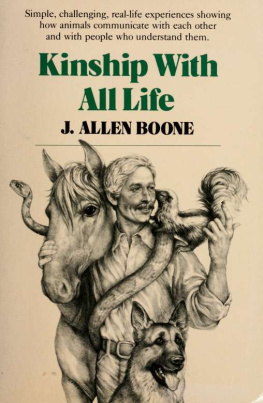KINSHIP IN ACTION
SELF AND GROUP
Andrew Strathern
and
Pamela J. Stewart
University of Pittsburgh
First published 2011 by Pearson Education, Inc.
Published 2016 by Routledge
2 Park Square, Milton Park, Abingdon, Oxon OX14 4RN
711 Third Avenue, New York, NY 10017, USA
Routledge is an imprint of the Taylor & Francis Group, an informa business
Copyright 2011 Taylor & Francis. All rights reserved.
All rights reserved. No part of this book may be reprinted or reproduced or utilised in any form or by any electronic, mechanical, or other means, now known or hereafter invented, including photocopying and recording, or in any information storage or retrieval system, without permission in writing from the publishers.
Notice:
Product or corporate names may be trademarks or registered trademarks, and are used only for identification and explanation without intent to infringe.
Credits and acknowledgments borrowed from other sources and reproduced, with permission, in this textbook appear on appropriate page within text.
ISBN: 9780131844841 (pbk)
Cover Designer: Suzanne Behnke
Library of Congress Cataloging-in-Publication Data
Strathern, Andrew.
Kinship in action: self and group/Andrew Strathern and Pamela J. Stewart.
p. cm.
Includes index.
ISBN-13: 978-0-13-184484-1 (alk. paper)
ISBN-10: 0-13-184484-9 (alk. paper)
1. Kinship. 2. Family. I. Stewart, Pamela J. II. Title.
GN487.S764 2010
306.83dc22
2010020495
To P.B. and T. ragl
CONTENTS
Kinship has made a comeback in anthropology. Not only is there a line of noted, general, introductory works and readers in the topic, but theoretical discussions have been stimulated both by artificial conception technologies and by reconsiderations of how to define kinship in the most productive ways for cross-cultural comparisons. Kinship studies have moved away from the minutiae of kin terminological systems, and the kinship algebra often associated with these, to the broader analysis of processes, historical changes, and fundamental cultural meanings in which kin relationships are implicated.
In this changed and changing context, we bring together in this volume a number of interests and concerns, to provide pointers for students, as well as for scholars, in the field of study. First, throughout the book, we take an explicitly processual approach. Kinship formations cannot be understood without exposition of structural frameworks, but these frameworks have also to be seen as historically situated and either potentially or actually changing because of their vital roles in larger processes. Second, from this processual vantage point, we examine the definition of terms such as kinship and the issues of filiation, descent, marriage, adoption, and the like. Third, our approach is invariably ethnographic. We seek not simply to illustrate our propositions with examples, but to draw the propositions from the case histories themselves. Fourth, and finally, we have deliberately often deployed materials from field areas where we have ourselves worked or the broader regions to which these areas belong, including the Pacific (especially Papua New Guinea), Europe (especially Scotland and Ireland), and Asia (Austronesian Southeast Asia, China, and Taiwan). This choice has of course not been exclusive. We take examples from all and any areas where relevant materials abound, and our scope is intended to be global, although in no way designed to be encyclopedic.
By using materials from works of fiction, we wish to indicate that fiction is also made out of process and can tell us much about historical patterns and themes of kinship-based relations. We have chosen illustrations of this point from Scotland and France, for instance, just as our other cases are drawn from places such as New Guinea: Whether already familiar to the readers or not, each example from fiction carries its relevant messages about succession, competition, desire, envy, and marriage, that belong to the ethnographic domains of life.
Our aim has been to explain the materials verbally, without recourse to kinship charts. These can be useful, of course. Sometimes they can also be confusing, so we have sought to make our discussions intelligible in their own terms. This means that we have avoided, as far as possible, language that is overly abstract or rarefied, while presenting the complex debates in the field.
Detailed information about kin terms in the two areas of Papua New Guinea which we have frequently alluded to in the book is given in an appendix, along with some remarks about the significance of kin terms in general (see ).
The title and subtitle of this book represent different facets of the same approach. Kinship in Action stands for our interest in process. Self and Group indexes some of the major debates on ideas of personhood that have emerged in discussions on kinship in social contexts. Throughout, we have also tried to bring together concerns derived from British, European, and North American traditions of analysis in the field, recognizing, for example, the importance of the work of both Meyer Fortes and David Schneider (to take two prominent names). In particular, as readers will perceive, we have discussed how many of the fundamental and deeply insightful ideas of Fortes can be released from their historical identification with structural-functionalism and brought to life again in contemporary contexts. With this book, we commemorate those who, like Meyer Fortes, have become ancestral figures and provide a platform for those whose work has yet to come. Long may kinship studies live and flourish.
Andrew Strathern and
Pamela J. Stewart
Cromie Burn Research Unit
University of Pittsburgh
November 2009
The idea for this book has been with us for many years. We have been interested in the topic and the fact that kinship studies have become more popular over the last two decades. Many years of teaching on kinship in a number of countries have also contributed to this volume.
We have included materials on kinship in many of our writings (e.g., Strathern and Stewart 2000a, 2000b, 2004), and we have had opportunities to discuss our work with colleagues when we were visiting scholars (e.g., University of Queensland, Brisbane, Australia; University of Otago, New Zealand, where we have worked on the copyedited chapters of this book in February 2010; Institute of Ethnology, Academia Sinica, Taiwan; Dong-hua University, Hualien, Taiwan; International Institute of Asian Studies, Leiden, The Netherlands; Minpaku, National Museum of Ethnology, Osaka, Japan; and the University of Aberdeen, Scotland).
We wish to thank the Office of Dean N. John Cooper, Faculty and School of Arts and Sciences, at the University of Pittsburgh, for long-standing support of our research and publication work. Thanks go to Ms. Catherine Rodgers for typographic assistance on sections of this book. We also thank everyone at Prentice Hall, especially Nancy Roberts, for their assistance and efforts in the production of this book. The extensive peer review of this manuscript has helped to strengthen it and we thank the five anonymous commentators for their suggestions. After our revisions and as this book goes to press, April 2010, the names of four of these evaluators were revealed to us by Prentice Hall. We thank them here: Dr. Richard Feinberg, Kent State University; Dr. Paul Sillitoe, Durham University; Dr. Julie David, California Baptist University, Orange Coast College; Dr. Michael McDonald, Florida Gulf Coast University.


